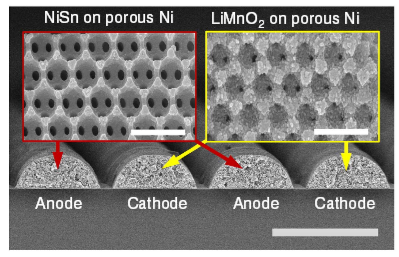New microbatteries a boost for electronics
April 19, 2013

Scanning electron microscopy (SEM) cross-section of a microbattery’s interdigitated electrodes spanning two periods. The interdigitated electrodes alternate between anode and cathode. The insets show the magnified electrodes with the nickel scaffold coated with nickel–tin on the left and lithiated manganese oxide on the right. Scale bars, 50mm and 1mm in the insets. (Credit: James H. Pikul et al./Nature Communications)
New microbatteries developed by researchers at the University of Illinois at Urbana-Champaign, out-power even the best supercapacitors and could drive new applications in radio communications and compact electronics.
“This is a whole new way to think about batteries,” said William P. King, the Bliss Professor of mechanical science and engineering. “A battery can [now] deliver far more power than anybody ever thought.
“In recent decades, electronics have gotten small. The thinking parts of computers have gotten small. And the battery has lagged far behind. This is a microtechnology that could change all of that. Now the power source is as high-performance as the rest of it.”
With currently available power sources, users have had to choose between power and energy. For applications that need a lot of power, like broadcasting a radio signal over a long distance, capacitors can release energy very quickly but can only store a small amount. For applications that need a lot of energy, like playing a radio for a long time, fuel cells and batteries can hold a lot of energy but release it or recharge slowly.
The new microbatteries offer both power and energy, and by tweaking the structure a bit, the researchers can tune them over a wide range on the power-versus-energy scale.*
The batteries owe their high performance to their internal three-dimensional microstructure. Batteries have two key components: the anode (minus side) and cathode (plus side). Building on a novel fast-charging cathode design by materials science and engineering professor Paul Braun’s group, King and Pikul developed a matching anode and then developed a new way to integrate the two components at the microscale to make a complete battery with superior performance.
With so much power, the batteries could enable sensors or radio signals that broadcast 30 times farther, or devices 30 times smaller. The batteries are rechargeable and can charge 1,000 times faster than competing technologies — imagine juicing up a credit-card-thin phone in less than a second. In addition to consumer electronics, medical devices, lasers, sensors and other applications could see leaps forward in technology with such power sources available.
Now, the researchers are working on integrating their batteries with other electronics components, as well as on manufacturability at low cost.
The National Science Foundation and the Air Force Office of Scientific Research supported this work. King also is affiliated with the Beckman Institute for Advanced Science and Technology; the Frederick Seitz Materials Research Laboratory; the Micro and Nanotechnology Laboratory; and the department of electrical and computer engineering at the U. of I.
* For conventional lithium ion batteries, typical volumetric power densities are 1–100 µW per square centimeter per micron and volumetric energy densities are around 10–60 µW h per square centimeter per micron.
The new U. of I. lithium ion microbatteries are rated at power densities up to 7.4 mW per square centimeter per micron and energy densities up to 15mW h per square centimeter per micron. They meet or exceed the power densities of the best supercapacitors, while retaining comparable energy density. Compared with other 3D microbatteries, the new lithium ion microbatteries have 2,000 times greater power density and 2 times greater energy density.
Note: Graphene micro-supercapacitors to replace batteries for microelectonics devices describes related microbatteries, but the UCLA specs are in are in volumetric instead of planar units, so they are incommensurate: 2.1 mWh cm-3 energy density (max), 141 W cm-3 power density.
UPDATE 4/19/2013: power- and energy-density information added.